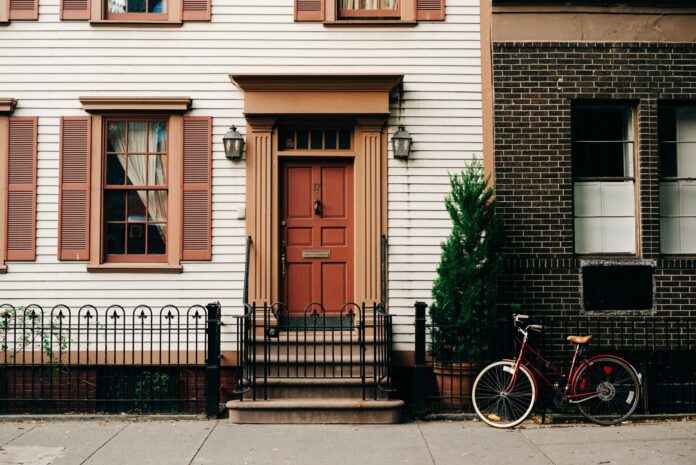Ground-floor apartments in big cities often get a bad rep. Many renters and buyers think of them as prime spots for soaking in the noise and pollution caused by traffic. Not to mention an ideal place for rodents to scavenge, with these and other vermin seeking refuge in the nooks and crannies near the sidewalk.
But, as city-dwellers who have lived in a maisonette will attest, all of that can be easily overlooked, knowing that a private oasis awaits them at home.
What Is a Maisonette?
A maisonette (pronounced “maize-on-et”) is a French word that means “little house,” a type of dwelling that’s larger than most apartments, but smaller than a house.
A maisonette is located on the ground level of a multi-unit building and has its own private entrance that can be accessed from the street. However, some maisonettes may be accessed from other areas within the property, such as a hallway or a courtyard, as long as there’s a dedicated, private entrance for the home.
Where Can You Find Maisonettes?
In New York City, you can find maisonettes in older buildings in neighborhoods like the Upper West Side, the Upper East Side, Sutton Place, and the West Village. But they can also be found in some parts of Brooklyn, including Brooklyn Heights, Fort Greene, Cobble Hill, and Park Slope.
A maisonette’s key feature is a private entrance on the ground level, usually decorated with planters, sconces, and a large door. In some cases, these private entrances may also be set back from the curb by a brick stoop or partially sectioned off with railings.
What’s the Appeal of a Maisonette?
We now know that a maisonette is more or less a euphemism for a first-floor apartment, so what makes it so appealing?
Well, for starters, maisonettes typically have a more intimate feel than a traditional apartment because they’re mixed in with rowhomes and other structures that exude “townhome-style” living.
As a result, those who live in a maisonette feel as though they’re living in a house as opposed to an apartment. The feeling is then amplified by the private entrance, which lends itself to a greater sense of separation from the other residents in the building.
Are Maisonettes Different From Townhomes?
Although some maisonettes are duplexes and triplexes, meaning they take up two or three floors in the building, they aren’t quite classified as townhomes in their own right.
Townhomes and brownstones take up the entire structure and are typically single-family residences. A maisonette, on the other hand, is only a portion of a multi-unit property that’s located on the ground floor, with other residents living in the same building.
Also, townhomes are usually set up for utilities as a whole. By contrast, a maisonette may be part of the property’s larger utility grid, with multiple renters and owners responsible for their individual energy usage.
What Are Other Pros and Cons of Maisonettes?
There are pros and cons to living in any type of housing, and maisonettes are no exception.
Some of the pros of living in a maisonette include:
- A sense of privacy and separation from other residents in the building, in part due to the growing appeal of townhome-style living in the city.
- In general, offers more space than a traditional apartment.
- May come with a backyard given its proximity to the ground level.
Some of the cons of living in a maisonette include:
- Possible exposure to passersby, street noise, and fumes, especially if the maisonette is located on a busy street.
- Lack of views, since maisonettes are located on the ground floor and may have windows facing other buildings or the interior of the property.
- Potential for low natural light, especially if the maisonette is located in the rear of the building.
How Much Do Maisonettes Cost?
The cost of a maisonette varies depending on the city where it’s located and the size of the unit.
Generally speaking, though, buyers can expect to spend millions for a maisonette that features a garden, multiple floors, and other luxurious amenities. In contrast, a traditional apartment in the same neighborhood may cost much less.
For example, a maisonette in New York City can go for $10 million or more, while a traditional apartment in a nearby co-op or condo may be priced in the $2 million to $3 million range.
Is It Worth It to Live in a Maisonette?
That’s ultimately a question that only the buyer can answer.
Some people may feel that a maisonette’s private entrance is a trade-off for less natural light and views, while others may find the added sense of townhome-style living to be a major selling point.
At the end of the day, it all comes down to what each individual is looking for in a home. If a maisonette fits those requirements, then there’s no doubt that it can be a great option.
Final Thoughts on Maisonettes
Maisonettes are redefining first-floor living for some renters and buyers in the big city, as they exist in a market class of their own. They can also be a solid choice for those who are looking for an urban dwelling with a little more character.
Although they come with a hefty price tag, they’re much cheaper than a full-blown townhouse in the same neighborhood while still affording the occupant a sense of townhome living.
Overall, those who don’t mind living on the ground floor may find value in a maisonette, even if it’s located on a busy street. Besides, what’s a little hustle and bustle when you have your very own private entrance to come home to?
Ivan Suazo is a copywriter and SEO blogger with over ten years of experience in the real estate industry. He's also the founder of a wellness blog, QWERTYdelight.com, and writes sleep stories for the Slumber App.



